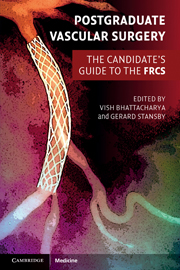Book contents
- Frontmatter
- Contents
- List of contributors
- Preface
- Section 1 Final FRCS vascular clinicals
- Section 2 Final FRCS vascular topics
- 1 Vascular risk factors and their management
- 2 Management of acute limb ischaemia
- 3 Chronic lower limb ischaemia, critical ischaemia and the diabetic foot
- 4 Endovascular and surgical options for peripheral revascularisation
- 5 Abdominal aortic aneurysms
- 6 Thoracic, thoracoabdominal and suprarenal aortic aneurysms
- 7 Aortic dissection
- 8 Popliteal artery aneurysms
- 9 Femoral artery aneurysms
- 10 Carotid, subclavian and vertebral disease
- 11 Diagnosis and management of thoracic outlet syndrome
- 12 Diagnosis and management of hyperhidrosis
- 13 Chronic mesenteric ischaemia
- 14 Acute ischaemic colitis
- 15 Vascular trauma
- 16 Indications and management of lower limb amputation
- 17 Leg swelling and lymphoedema
- 18 Varicose veins and chronic venous insufficiency
- 19 Management of deep vein thrombosis
- 20 Infection in vascular surgery
- 21 Vascular malformations
- 22 Vasospastic disorders and vasculitis
- 23 Critical care considerations and preoperative assessment for general and vascular surgery
- 24 Access surgery
- 25 Basic outline of solid organ transplantation
- Index
- References
9 - Femoral artery aneurysms
- Frontmatter
- Contents
- List of contributors
- Preface
- Section 1 Final FRCS vascular clinicals
- Section 2 Final FRCS vascular topics
- 1 Vascular risk factors and their management
- 2 Management of acute limb ischaemia
- 3 Chronic lower limb ischaemia, critical ischaemia and the diabetic foot
- 4 Endovascular and surgical options for peripheral revascularisation
- 5 Abdominal aortic aneurysms
- 6 Thoracic, thoracoabdominal and suprarenal aortic aneurysms
- 7 Aortic dissection
- 8 Popliteal artery aneurysms
- 9 Femoral artery aneurysms
- 10 Carotid, subclavian and vertebral disease
- 11 Diagnosis and management of thoracic outlet syndrome
- 12 Diagnosis and management of hyperhidrosis
- 13 Chronic mesenteric ischaemia
- 14 Acute ischaemic colitis
- 15 Vascular trauma
- 16 Indications and management of lower limb amputation
- 17 Leg swelling and lymphoedema
- 18 Varicose veins and chronic venous insufficiency
- 19 Management of deep vein thrombosis
- 20 Infection in vascular surgery
- 21 Vascular malformations
- 22 Vasospastic disorders and vasculitis
- 23 Critical care considerations and preoperative assessment for general and vascular surgery
- 24 Access surgery
- 25 Basic outline of solid organ transplantation
- Index
- References
Summary
Key points
Lower limb arterial aneurysms rarely occur in isolation
The majority present either as an incidental finding or as lower limb ischaemia
Aneurysm rupture is rare, but life- and limb-threatening when it occurs
All symptomatic femoral artery aneurysms should undergo repair
Asymptomatic femoral artery aneurysms >2.5 cm in maximum diameter should be considered for elective repair
True femoral aneurysms
Incidence
Femoral artery aneurysm (FAA) is the second most common peripheral artery aneurysm after popliteal artery aneurysms. They most often occur in male patients over 65 years with an age-adjusted incidence of combined femoral and popliteal artery aneurysms of 7.39 per 100,000 population in the USA; male-to-female ratio of 10:1. Patients with FAAs demonstrate a high incidence of cardiovascular disease and associated risk factors, including hypertension, smoking and hypercholesterolaemia. Diabetes mellitus appears to be protective for femoral artery aneurysm. Although FAAs predominantly occur in association with atherosclerotic disease, there are reports available in the English literature suggesting an association with vasculitides and connective tissue disorders.
FAAs rarely occur in isolation and are frequently associated with a contralateral aneurysm or/and aneurysmal disease affecting the aorta or other peripheral arteries. In a cohort of 100 patients with FAAs Graham et al. reported 72% were bilateral, 85% were associated with aorto-iliac aneurysms and 44% were associated with popliteal artery aneurysms. Alternatively, the incidence of FAAs in patients with abdominal aortic aneurysms is ≈5%.
Pathophysiology
The pathophysiological conditions predisposing to the development of FAAs are poorly understood.
- Type
- Chapter
- Information
- Postgraduate Vascular SurgeryThe Candidate's Guide to the FRCS, pp. 123 - 128Publisher: Cambridge University PressPrint publication year: 2011



